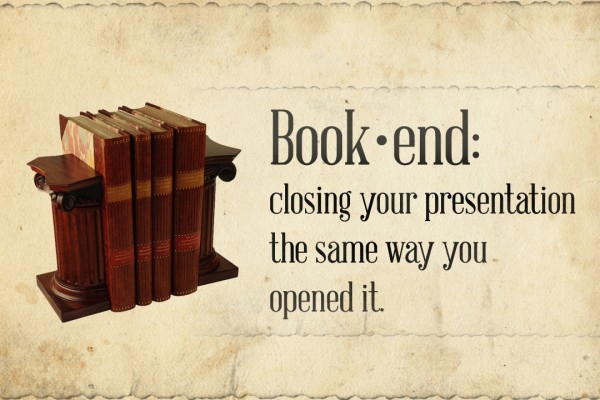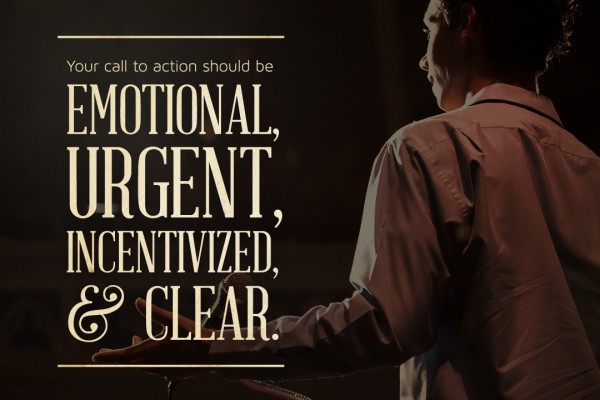The ending of your presentation is like a battle cry, a crack of a whip, or even a well-deserved high five for your audience. In order for it to be a success, it needs to rally people to action by appealing to their hearts and minds, sticking with them long after the boardroom lights have been turned off. So, how can you end your presentation with a “rah-rah” spirit that moves your listeners? Here are a few suggestions:
Repetition
This kind of ending can either revisit some of your key takeaways, or can simply be a repeated phrase that leaves a potent emotional impact. For example, consider the way that Abraham Lincoln ended the Gettysburg Address with three repetitions of “the people”: “and that government of the people, by the people, for the people, shall not perish from the earth”
Why does repetition work? The magic behind it is all scientific. For a while, neurobiologists knew that learning happens when new connections are built between brain nerve cells. In 1999, a neurobiologist named Joe Tsien found that special communication channels in our nerve cells called NMDA receptors create new connections with associative (repetitive) learning. But it becomes a little more interesting with a protein called GAP-43. This protein makes nerve connections form quickly, and happens when the same combinations of nerve signals are repeated over and over. So, when Lincoln says “of the people, by the people, and for the people,” our GAP-43 proteins are triggered in response to hearing “the people” repeated, and those nerves cells start to make a new connection that we remember later. These connections are a recipe for a potent memory-boosting way to end your presentation.
Leave Them Hopeful
Sometimes you have to deliver a difficult message. For instance, profits are down, global warming is up, and it looks like there might be a nationwide cupcake shortage. This doesn’t mean you need to leave your audience feeling unmotivated and unhappy. Consider instead ending on a hopeful sentence or two that encourages and uplifts your audience, giving them motivation to act on your words rather than go home and have a good cry about them.
One great example of this comes from the master of “we’ve got some bad news” speechmaking, Winston Churchill. During the summer of 1940, things were not looking good for England. During the threat of a likely German invasion, Prime Minister Winston Churchill knew that he to warn the country and prepare them for the absolute worst. His “finest hour” speech accomplished just that, ending on a note that became famous for its spirit of determination in the face of the worst news ever: “Let us therefore brace ourselves to our duty and so bear ourselves that if the British Commonwealth and Empire lasts for thousands of years, men will say: ‘This was their finest hour.’ ”
Refer Back to the Opening
Give your audience a sense of closure by repeating your opening statement, or referring back to an introductory idea. Movies often visually use this technique when they repeat the opening shot of the film as an identical last shot. This can be a subtle and sometimes humorous way to remind viewers of how they felt before the journey began, or what they were initially thinking at the start of the movie. You can do the same by taking them on a verbal journey back to your powerful opening. This kind of closing is also known as a “bookend,” because it wraps up the speech in the same or similar way as the start.
End on the Call to Action
Your call to action is one of the most important elements of a presentation; why not make it the last thing your audience hears? From signing up to a newsletter, sharing all of their money, or simply visiting your website, these actionable items can encompass anything you want your audience to do when they are finished listening to you talk.
After you’ve decided what you want the audience to do, there are four elements of a great call to action:
1. It Should Be Emotional – Don’t let your message merely appeal to their wallets. Make them feel like they are missing out on something good, or that they are going to be part of something that does good, or even that they’re going to feel good when it’s all over.
2. It Should be Urgent – A lengthy timeline for your “need” is going to cause people to procrastinate and eventually forget your call to action. Make them feel as if they should be getting out their computers and wallets and cell phones the moment after the presentation ends.
3. It Should Have Incentive – What’s in it for them? Be sure that the incentives for your call to action are laid out and tempting. Offering a stale doughnut and a business card after the presentation isn’t going to be the long-term incentive that your audience may need. In that case, ask yourself: “what do they want?”
4. It Should Be Clear – What you want them to do should be conveyed in one or two sentences and clear as a freshly washed window pane. Don’t leave your audience guessing with obscurities and hesitant “maybe you should…” Be direct.
Finish With a Question
Sometimes called a “call to question,” this technique can leave your audience with a hypothetical (or actual) question that keeps their brains churning long after the speech. They can be challenging: “what are you going to do about it?” or thought provoking: “how many times have you thought about drinking water?” etc.
Speaking directly at your audience is also similar to a technique in film and theater known as “breaking the 4th wall.” In which, the normal boundary set between speech-makers and audience is “broken” or comedic or compelling effect. Here are some famous film instances of breaking the 4th wall, whether they include questions or direct statements intended for the audience:
Storytelling
Since storytelling is such a powerful way to open a presentation, you can use this technique again later to finish the story you began in the introduction. Or, perhaps consider weaving a separate yet still relevant tale that ties up the points you introduced throughout the core content of the presentation.
If you’re not convinced that storytelling is an effective tool for boardrooms and business pitches, you might be sold when you learn the science behind it. Storytelling ignites the insular cortex within the brain, which helps us relate to pain, happiness, disgust, and other emotions in people. This is why when someone tells us a tale about how they broke their arm or ate the most delicious chocolate cake of all time, parts of our brain become engaged to “share” the storyteller’s emotions.
You don’t have to use a story that ends with “happily ever after” to finish on a memorable note. Instead consider weaving a narrative throughout your presentation and finishing that tale with a surprise, hopeful, or emotionally meaningful ending.
The Ol’ Quotation
“Sometimes a powerful quotation can add credibility to your argument.” – This Article
Already delivered a great call to action? Shared enough stories? Asked enough questions? One classic way to end a presentation or speech is with the authority of a well-picked quote. These can be humorous, serious, or ironic, but they will almost always be easy to remember and make it seem as if you fully prepared for the event. A quote can also serve to reinforce the other ideas mentioned in this article; supporting a call-to-action, giving audiences a sense of hope, and providing a hypothetical question.
Consider this powerful quote from Theodore Roosevelt as a way to close your presentation with a punch: “We have too much to do to sit on the sidelines. We need you to step out of the gray twilight into the bright sunshine so that we can all see the dawn of a new day.”
No matter how you choose to end your presentation, don’t be like a rockstar who exits the stage five times to return five times at the sound of slight applause. Finish strong by keeping your exit brief and leaving your audience as riled up as a Aragon’s troops at the Black Gate in Lord of the Rings:
Question: How can you powerfully end your presentation?


